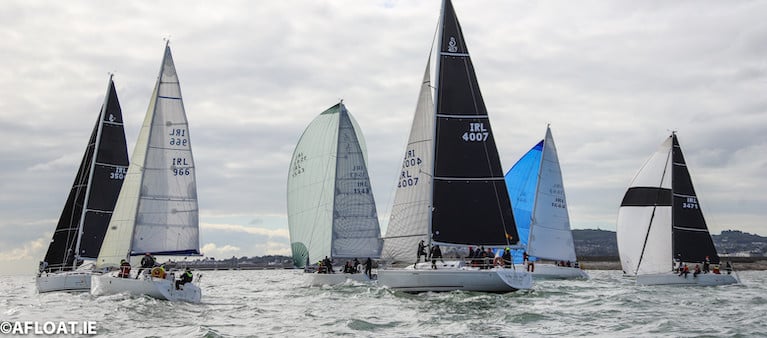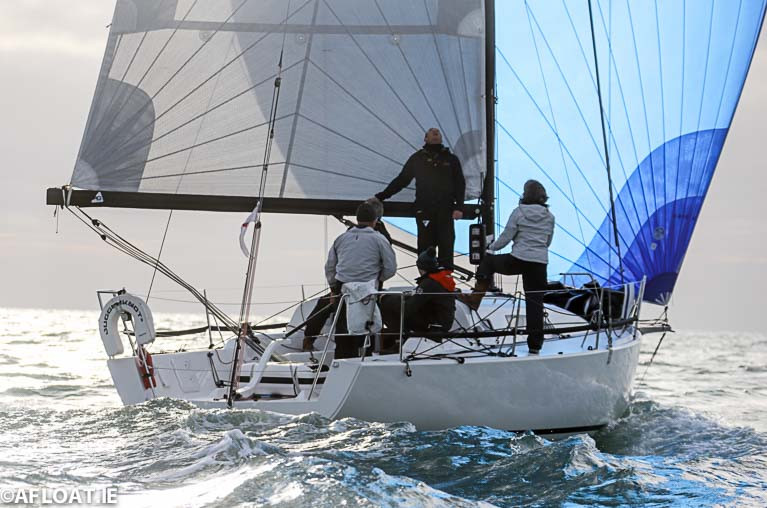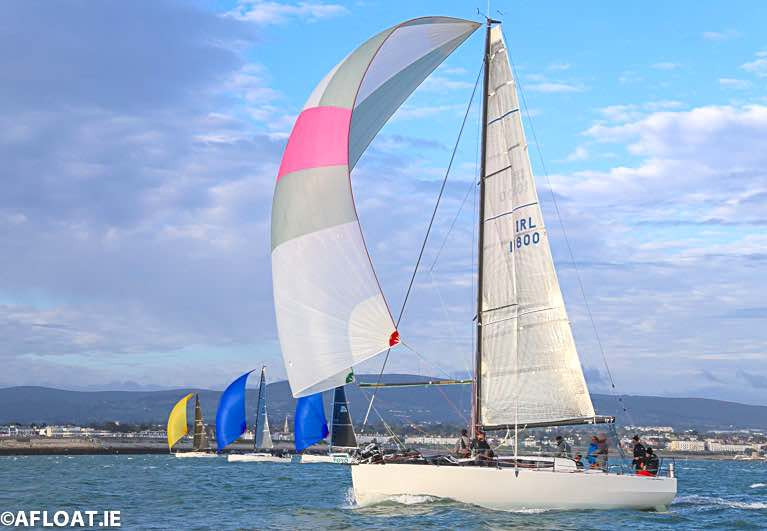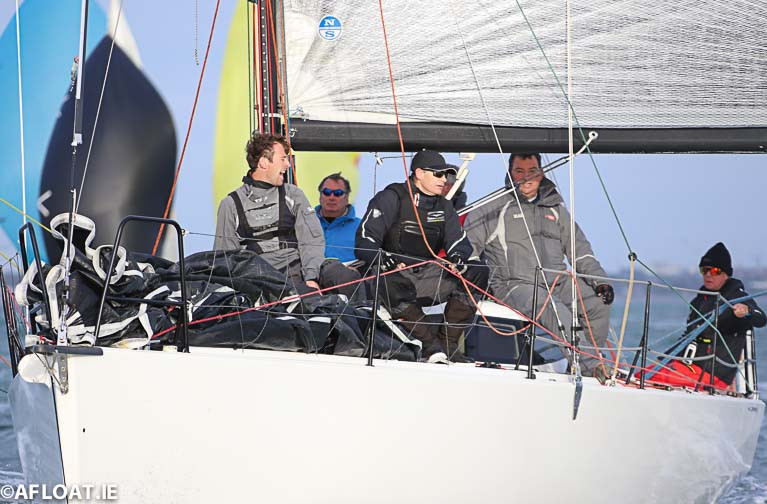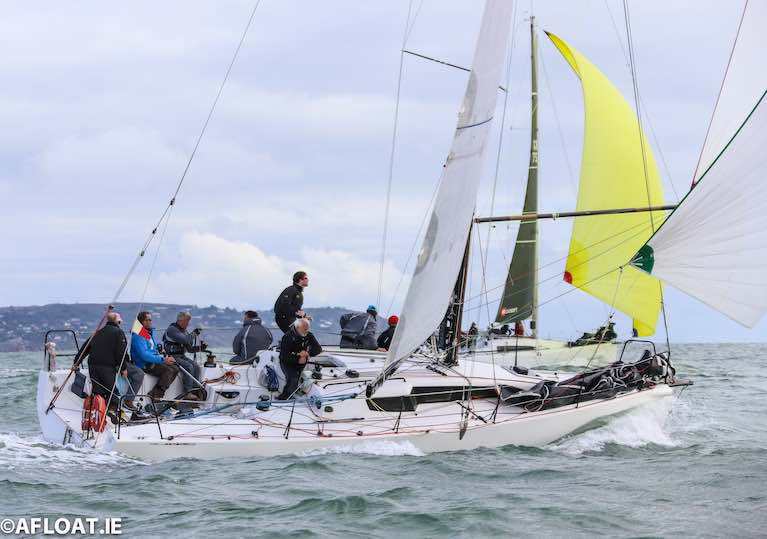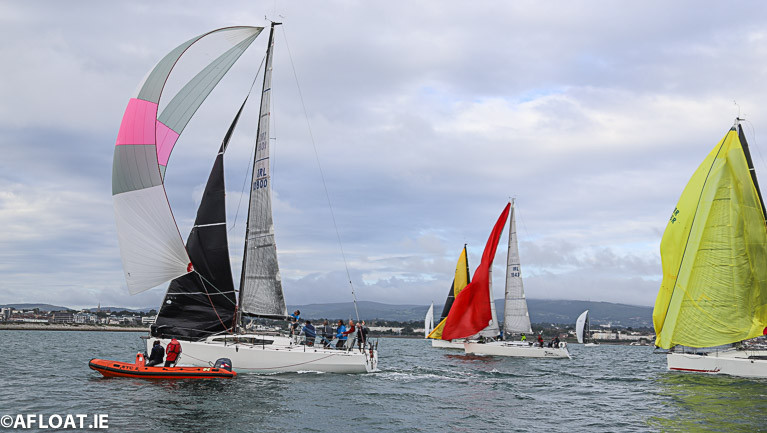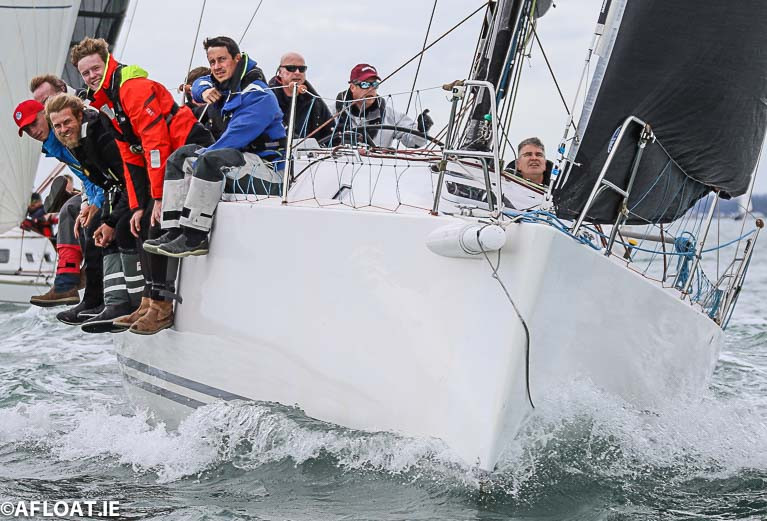Displaying items by tag: ISORA
Two Early 2021 Dublin Sailing Fixtures Impacted By COVID
Two of 2021's early-season cruiser-racer sailing fixtures on Dublin Bay are up in the air due to January's lockdown restrictions.
A new ISORA 'Early Season Series' originally planned for this month was to continue the offshore's body's successful 2020 coastal racing out of Dun Laoghaire Harbour. However, the current lockdown has put paid to those plans, leaving ISORA boss Peter Ryan to reschedule.
"We had planned for January but that's not going to happen. So, rather than cancel, we will reschedule those races into a potentially tighter programme as soon as possible", Ryan told Afloat.
The 2020 ISORA Coastal Series attracted a dozen or more entries and typically involved a race using virtual marks along the County Dublin and Wicklow coasts.
Ryan's offshore enterprise won him an end of the year gong. The NYC sailor took an Afloat Sailor of the Month Award in December for his success in staging an ISORA series in lockdown in 2020.
DBSC Spring Chicken
Meanwhile, following the total abandonment of its popular Turkey Shoot pre-Christmas event, the hope is that Dublin Bay Sailing Club will be in a position to run its Spring Chicken Series that starts traditionally in the first week of February.
The series of six races are held on Sunday mornings and organised by DBSC attracting as many as 40 boats.
However, as COVID lockdown restrictions are set to continue nationally until January 30th, fears are that there is now every chance that restrictions could also impact DBSC's spring fixture too.
The popular Spring Chicken format features short, sharp races typically of around one hour in duration.
In a new year announcement, DBSC was named as 2021 Sailing Club of the Year for its achievements in keeping sailing going on Dublin Bay during the lockdown in 2020.
Peter Ryan of the National Yacht Club is "Sailor of the Month (Services to Sailing)" for December
Peter Ryan of Dun Laoghaire is a dedicated sailing enthusiast – particularly for offshore racing – whose affable exterior camouflages the fact that his brain is busily whirring with ideas for improving the sport. Thus when the challenges of pandemic shutdown arose, he grasped the opportunities provided by being Chairman of the Irish Sea Offshore Racing Association, and having access to a generously donated consignment of Yellowbrick trackers, to set about devising a programme which would comply with regulations while still providing good sport.
It may not have been offshore racing as we know it, as it lacked the post-race parties previously thought indispensable. But it was a proper coastal racing programme nevertheless, with an overall champion (Paul O'Higgins' JPK 10.80 Rockabill VI, RIYC) by the final race in September, while the general ISORA contribution to the legitimate continuation of the sport was also seen in the loan of the Yellowbricks for the excellent Fastnet 450 race in August, and the hugely successful Round Ireland Two-Handed Speed Challenge by Pam Lee of Greystones and Cat Hunt with the Figaro 3 Iarracht Maigeanta in October.
But then Peter Ryan is no stranger to success – he was Commodore of the National Yacht Club in 2011 when it became the Mitsubishi Motors Sailing Club of the Year.
 Responsibility worn lightly - Peter Ryan as Commodore of the National Yacht Club in 2011.
Responsibility worn lightly - Peter Ryan as Commodore of the National Yacht Club in 2011.
Peter Ryan Re-elected ISORA Chairman for 2021 Offshore Sailing Season
Peter Ryan, who was first elected to chair ISORA in 2007, will lead the Irish Sea offshore sailing body into the 2021 season following his reelection as chairman at November's virtual ISORA AGM hosted by Pwhelli Sailing Club.
Ryan, of the National Yacht Club in Dun Laoghaire Harbour, is the only Irish Flag Officer in an otherwise Welsh-based executive with Vice Chairman Peter Dunlop and Stephen Tudor remaining as Secretary/Treasurer and Webmaster, both of Pwhelli Sailing Club. The Social Media Secretary is Victoria Cox.
ISORA's General Sailing Committee, that decides on coastal and offshore race courses, also carry the remit of providing guidance and encouragement for other competitors. The 2021 committee includes a number of key competitors including three Royal St. George skippers, Chris Power Smith of J122 Aurelia, Lindsay Casey, skipper of the J97 Windjammer and Brendan Coghlan, from the Sunfast 3600, Yoyo.
 Brendan Coghlan's Sunfast 3600, Yoyo. Photo: Afloat
Brendan Coghlan's Sunfast 3600, Yoyo. Photo: Afloat
Full details of the ISORA Committees are here.
How Will COVID-19 Affect Yacht Racing in 2021?
Four-time Olympic keelboat helmsman Mark Mansfield, a regular competitor at Irish IRC and one-design regattas and Irish agent for some well-known sailing brands, reviews how the 2020 sailing season 'happened' in pandemic and considers what could be done to keep the scene alive in 2021
2020 will likely go down as one of the strangest ever yacht racing seasons. It started back in January with great optimism, looking forward to such events as the Round Ireland Race, The 300th Anniversary Cork Week Regatta, Bangor Regatta on Belfast Lough and Wave Regatta in Howth. In the end, though some regattas were rescheduled for later in the year, all foundered with the ups and downs of the dreaded Covid-19 pandemic.
In the few months from May to August, some reasonable racing was allowed to be had at club level around the country, including a decent number of DBSC races on Dublin Bay and a revamped ISORA series from Dun Laoghaire Harbour.
 Article author Mark Mansfield suggests reduced crew numbers and an emphasis on coastal course racing can help to keep cruiser-racer going in 2021
Article author Mark Mansfield suggests reduced crew numbers and an emphasis on coastal course racing can help to keep cruiser-racer going in 2021
One of the highlights was a pop up offshore fixture, the inaugural 260-mile Fastnet 450 Race, which involved a race from Dun Laoghaire on the East Coast around the Fastnet Rock on the South Coast and into Cork Harbour, all held under strict no contact Covid regulations with an online briefing and prizegiving.
 The winner of the Fastnet 450 Race was Royal Cork yacht Nieulargo (Denis and Annamarie Murphy Photo: Afloat
The winner of the Fastnet 450 Race was Royal Cork yacht Nieulargo (Denis and Annamarie Murphy Photo: Afloat
Clearly, the lessons learned in 2020 will need to be brought into 2021 to see what was successful, and what was not.
Going forward, large onshore events which involve a lot of socialising and shoreside entertainments will not likely be a runner again in 2021. So how should we be preparing to ensure 2021 allows decent racing and allows owners to get good use out of their boats? Here are some suggestions and thoughts on this.
Boat crew numbers
When Afloat published my thoughts on the 12th of May about how keelboat racing work can with social distancing, I suggested that reducing cruiser crew numbers while racing would assist in social distancing and project the right image.
This article was picked up by the international sailing media and carried by websites around the world. I got a lot of positive feedback.
 A screenshot of Mark Mansfield's May article in Afloat setting out how keelboat racing can be kept going in pandemic
A screenshot of Mark Mansfield's May article in Afloat setting out how keelboat racing can be kept going in pandemic
In Ireland, Irish Sailing, the national governing body, decided to effectively open up to full crews on yachts, after initially being ultra-cautious and allowing no cruiser-racing apart from same household crews. Then, when Level 3 came in, all racing was closed down again, despite other sports continuing to compete. This course of action and the zig-zag nature of their direction has led to a lot of disquiet and it continues.
In the UK, when they allowed cruiser racing to open up, it initially was with household crews, then when this was extended it was with limited numbers while racing.
80% of a boats IRC crew number rounded to the nearest whole number was the norm with events such as the RORC IRC National Championships and the J Cup, both held under these restrictions.
I appreciate sailing happens in the open air and it has been rare to find anyone being infected with Covid-19 while sailing, however, reducing crew numbers shows the sport is making the effort and the optics are much better. Eight bodies sitting out shoulder to shoulder on a 35-footer does not give the right impression.
 Before COVID - The successful Dublin Bay J109 Joker II going upwind in Kinsale at the 2017 ICRA Nationals – which she won
Before COVID - The successful Dublin Bay J109 Joker II going upwind in Kinsale at the 2017 ICRA Nationals – which she won
With many owners struggling to fill full crew positions on their boats anyway, restricting all boat crew numbers could also help level the playing field. Maybe Irish Sailing and the Clubs it represents could look at this as an option to allow racing to continue next year?
2021 Irish Sailing Calendar
2021 is scheduled to be another big year if Covid allows it. For cruiser-racers around the country, you have, in addition to DBSC, ISORA and other club racing, the following big events.
- Scottish Series, Tarbert, 28th May to 31 May 2021
- Dun Laoghaire Dingle Race, 9th June
- Sovereign's Cup, Kinsale, 23rd to 26th of June
- Bangor Town Regatta, Belfast Lough, 24th to 27th June
- Volvo Dun Laoghaire Regatta, 8th to 11th July
- Calves Week, Schull, 3rd to 6th of August
- ICRA Nationals, National YC, 3rd to 5th of September
Add to this WIORA in Tralee, and perhaps another Fastnet 450 Race and this could be a really great season—if it all goes ahead. So how does sailing position itself to be able to complete these larger regattas in what will likely still be a Summer of Covid restrictions? The answer has to be:
Good PR – Highlighting the Covid restrictions to make everyone safe—no gatherings, no briefings, no in-person prizegivings. Highlight the sailing, not the shore activities.
Reduce crew numbers – see above
Provide more coastal and longer races – rather than the three races a day that is the norm. Shorter races with more turning marks need more crew aboard and all the crew end up coming ashore at the same time. Longer Coastal races need fewer people and the boats come back home on a staggered basis.
Prepare a strong 'Plan B' – for having no onshore events or contact. July's Dun Laoghaire Regatta with four clubs to dissipate people, an on-site marina and a large town just behind, are already anticipating this by separating the event into one designs one weekend and IRC racing the next.
More offshore racing
Offshore and long coastal racing needs to be included more in boat owners plans if they are to get value from their investment. As the Fastnet 450 Race showed, there is an increasing appetite for this form of the sport, and in these Covid times, that interest has grown further. Offshore racing, with limits on crew numbers, allows for relatively safe sailing with crews being able to stay apart easier and boats arriving back to port looking for rest rather than social interaction.
 ISORA managed to run eight coastal races off Dun Laoghaire Harbour this season keeping the Irish Sea offshore scene very much alive despite the pandemic Photo: Afloat
ISORA managed to run eight coastal races off Dun Laoghaire Harbour this season keeping the Irish Sea offshore scene very much alive despite the pandemic Photo: Afloat
ISORA can be congratulated for growing this form of the sport in Ireland and Wales and even in this difficult year, they were able to get in a range of races, all be it without being able to mix the Irish and welsh boats. The combination of shortish offshore races and long coastal racing has been very popular in 2020 and I expect you will see a few more boats join their ranks in 2021.
On the South Coast, there is a move afoot to come up with a similar series to link the Fastnet 450 race with the Kinsale/Fastnet/Kinsale race and then add some coastal day races to form a series. More to follow on this.
 ISORA Champion Rockabill VI (Paul O'Higgins) from the Royal Irish Yacht Club
ISORA Champion Rockabill VI (Paul O'Higgins) from the Royal Irish Yacht Club
Fingers crossed a vaccine or better treatments for Covid will come quickly, but it is doubtful that they will come quickly enough to mean our 2021 season will be back to normal. We have to expect that 2021 will be disrupted again, and now it the time to plan for this. With some small changes, a bit of luck and a bit of goodwill all or most of these big events above can happen and be a great success. Let's plan for the worst but hope for the best.
Mark Mansfield is an Irish agent for Quantum Sails and J Boats/Grand Soleil in Ireland. More details below.
Irish Sea Offshore Racing Association (ISORA) racers will agree the 2021 Race Schedule early next month but like most things to do with the 2020 offshore season it will be a little different so there is no surprise that this year's Annual General Meeting will be conducted virtually.
Despite the ongoing threat of COVID-19, the association managed to conduct a full season of coastal fixtures on both sides of the Irish Sea although no cross-channel racing was completed. As regular Afloat readers will know, a win in September's final race of the IRC Series gave overall victory to Royal Irish Yacht Club crew Rockabill VI (Paul O'Higgins). The last coastal race win sealed the COVID-hit season after eight races sailed with five to count.
Now, the ISORA fleet is gathering again, not as usual for the annual National Yacht Club power-wow, but virtually by 'Zoom' on Saturday, 7th November 2020 at 11.00 hours for the AGM.
ISORA's Hon Sec Stephen Tudor has set out the order of business of the meeting in a notice on the association's website:
- To approve the minutes of the previous AGM.
- To approve the accounts for the year to November 2020
- To elect Officers of the Association for the ensuing year.
- To elect members of the Committee
- To agree the 2021 Race Management Detail and Proposed Race Schedule
The meeting is for the following categories:
- 2019 and 2020 Skippers, or their appointed representative
- 2021 prospective Skippers, or their appointed representative
- 2020 Committee Members
- 2021 Committee Members (proposed)
- Yacht/Sailing Club Representatives
Voting will be restricted to one vote per ISORA participating boat. Questions for the AGM to be forwarded to the Hon Sec before 2nd November 2020
To attend please complete the 'AGM attendance invitation request form' here so that the Zoom invitations can be circulated by e-mail.
Paul O'Higgins is Sailor of the Month (Offshore) for September
One of the many "little miracles" which kept Irish sailing alive and active during the continually-changing official restrictions in the summer of 2020 was the flexible and effective administration of the Irish side of the Irish Sea Offshore Racing Association's annual programme by ISORA Chairman Peter Ryan of the National YC.
But in order to succeed in this, he needed the support of the skippers and crews who enjoy what ISORA has on offer, yet in a normal year would be able to plan their programme well in advance.
This wasn't possible in 2020, but thanks to a generous spirit among those involved, the Irish boats in ISORA had a very good season in the circumstances. Once again it came down to the outcome of the last race in September, and once again the final race overall winner, and new 2020 champion, was Paul O'Higgins (Royal Irish YC) with the JPK 10.80 Rockabill VI.
Paul O'Higgins & Rockabill VI Crew Crowned 2020 ISORA Overall Winners
A win in Saturday's ten-boat James Eadie final race of the 2020 ISORA IRC Series gave overall victory to Royal Irish Yacht Club crew Rockabill VI. The last coastal race win sealed the COVID-hit season after eight races sailed with five to count.
Scroll down for photo slideshow.
The Class 0 JPK 10.80 Rockabill VI finished on 500.9 points, some 33 points ahead of second overall the class one J99, Juggerknot, skippered by Andrew Algeo, also of the Royal Irish Yacht Club. Third place overall went to the Class 0 J/122 Aurelia sailed by Chris Power-Smith from the Royal St.George Yacht Club.
In the absence of the Overall Championship, The Wolf’s Head, there are now two offshore champions. As government regulations prevented any traditional cross channel offshore races, two separate series were run on each side of the Irish Sea. A total of 16 races were run, 8 on each side. As there was no mixing of the fleet, the Wolf’s Head trophy for the overall ISORA champion was withdrawn.
On the UK side, Peter Dunlop’s “Mojito” took the ISORA UK / Welsh Offshore Championship 2020.
Class 1 was won by Andrew Algeo’s “Juggerknot2” and Class 2 was won by Grzegorz Kalinecki’s “More Mischief”.
 2nd - IRC Class 1 Juggerknot 2 IRL 3990 J99 Royal Irish Yacht Club Andrew Alego
2nd - IRC Class 1 Juggerknot 2 IRL 3990 J99 Royal Irish Yacht Club Andrew Alego
 3rd - IRC Class 0 Aurelia IRL 35950 J122 Royal St George Yacht Club Chris & Patanne Power Smith
3rd - IRC Class 0 Aurelia IRL 35950 J122 Royal St George Yacht Club Chris & Patanne Power Smith
 4th - IRC Class 0 Hot Cookie GBR7536R Sunfast 3600 National Yacht Club John O'Gorman
4th - IRC Class 0 Hot Cookie GBR7536R Sunfast 3600 National Yacht Club John O'Gorman
 5th IRC Class 2 More Mischief IRL 966 First 310 ISA Grzegorz Kalinecki
5th IRC Class 2 More Mischief IRL 966 First 310 ISA Grzegorz Kalinecki
James Eadie Final ISORA Race at Dun Laoghaire Harbour Photo slideshow
Royal Irish's Rockabill VI Crew are Viking Marine 2020 ISORA Coastal Series Champions
Today's last race of the four-race Viking Marine sponsored ISORA Coastal Series was the only one to have started with any breeze above ten knots, providing a suitable send-off for the 12-boat fleet finale.
Overall leader Rockabill VI (Paul O'Higgins) from the Royal Irish Yacht Club sealed the series with a final race win against competition from Chris Power Smith's J122 Aurelia of the Royal St. George Yacht Club, who finished second overall and John O'Gorman's Sunfast 3600 Hot Cookie from the National Yacht Club who ended the series in third.
 A good turnout for the final race of the coastal series and the penultimate ISORA race of 2020
A good turnout for the final race of the coastal series and the penultimate ISORA race of 2020
The increasing appetite for offshore racing was reflected in the fact that many of today's fleet (including second and third places overall) were racing to Cork a week ago in the inaugural Fastnet 450 Race but had still managed to position back to the Bay for today's final round with a prompt 10 am start provided by National Yacht Club Race Officers Barry MacNeaney and Larry Power.
 Andrew Alego's Juggerknot II (leeward boat) and Paul O'Higgins' Rockabill VI arrive at the reaching start line of race four of the ISORA coastal series with seconds to go Photo: Afloat
Andrew Alego's Juggerknot II (leeward boat) and Paul O'Higgins' Rockabill VI arrive at the reaching start line of race four of the ISORA coastal series with seconds to go Photo: Afloat
 (Above and below) With a gybe on to port, Juggerknot II is first to hoist. John O'Gorman's Hot Cookie is a boat length behind at the Committee Boat
(Above and below) With a gybe on to port, Juggerknot II is first to hoist. John O'Gorman's Hot Cookie is a boat length behind at the Committee Boat 
Of course, today's modest 35-mile coastal course was nothing compared that arduous 270-miler last weekend but nevertheless today's five-hour run along the Wicklow coast presented its fair share of tactical decisions too.
After the usual start off the Dun Laoghaire Harbour outfall buoy, the fleet sailed to a virtual mark before heading for the North Kish cardinal mark and then a long reach to the Breaches Buoy before the beat back up the coast to the Muglins at the Southern Tip of Dublin Bay and a finish at the Harbour Mouth at Dun Laoghaire.
 There were some strong north-westerly gusts shortly after the start
There were some strong north-westerly gusts shortly after the start
In IRC overall today, the result mirrored the overalls for the series with Rockabill winning from Aurelia and Hot Cookie. In IRC Zero, Keith and Rodney Martin's Lively Lady was third.
In IRC One, Hot Cookie won from Juggerknot 2 (Andrew Alego). Simon Knowles J109 Indian was third.
In IRC Two, Black Velvet (Leslie Parnell) won from More Mischief (Grzegorz Kalinecki). Wardance (Sean Hawkshaw) was third.
The results are here
 Lively Lady (Rodney and Keith Martin) was third in IRC Zero
Lively Lady (Rodney and Keith Martin) was third in IRC Zero
 Lively Lady (Rodney and Keith Martin) was third in IRC Zero
Lively Lady (Rodney and Keith Martin) was third in IRC Zero  Vincent Farrell's First 40.7 Tsunami from the National Yacht Club
Vincent Farrell's First 40.7 Tsunami from the National Yacht Club
 Grzegorz Kalinecki's First 310 More Mischief
Grzegorz Kalinecki's First 310 More Mischief
 Andrew Algeo's Juggerknot II - racing fully crewed for the first time in the Coastal Series
Andrew Algeo's Juggerknot II - racing fully crewed for the first time in the Coastal Series
ISORA's Final Race Weighted 1.3 & Likely to Determine Irish & UK Offshore Championships
ISORA has cancelled its traditional end of season climax, the James Eadie Race from Pwllheli to Dun Laoghaire set for 5th September. The decision comes as a result of the worsening COVID situation.
Instead, ISORA will stage separate races on either side of the Irish Sea. The Welsh will race from Pwllheli to Holyhead.
The final race of 2020 for Dublin offshore sailors will be held off Dun Laoghaire Harbour starting and finishing in the south Dublin Bay port.
The last race is weighted 1.3 so it will be significant in determining the overall positions for the Irish and UK/ Welsh ISORA offshore championships.
ISORA Boats Line Up for Final Race of Viking Marine Coastal Series off Dun Laoghaire Harbour
Despite all the setbacks of season, there is a busy climax for ISORA's 2020 offshore racers with two more races following quickly in the wake of last weekend's inaugural Fastnet 450 Race.
The Royal St. George line honours winner, Aurelia, will be back on her home Dublin Bay race track this Saturday for the final race of the ISORA Viking Marine Coastal Series 2020.
Chris Power Smith's J122 is among a number of ISORA boats that completed last week's 270-mile Dublin to Cork offshore that return to the fray for the 35-mile Dun Laoghaire Coastal Race.
Lying first overall is Paul O'Higgins' Rockabill VI, second is Power Smith's Aurelia and third is the Skerries-based J109 Mojito campaign.
 The Archambault A31 A Plus is an ISORA Race winner Photo: Afloat
The Archambault A31 A Plus is an ISORA Race winner Photo: Afloat
According to ISORA chief Peter Ryan, also racing will be the Archambault 31 A Plus, the J99 Juggerknot 2, the J109 Indian, the X-45 Samatom, the Sunfast 3600 Hot Cookie and possibly her sistership YoYo too.
 Andrew Algeo's Juggerknot 2 at the Fastnet 450 Race start on Dublin Bay. Photo: Afloat
Andrew Algeo's Juggerknot 2 at the Fastnet 450 Race start on Dublin Bay. Photo: Afloat
Unfortunately, it looks like the season has ended for Greystones competitor Red Alert that was dismasted racing to Cork Harbour.
This Saturday's final race has an overall 0.9 weighting.
National Yacht Club Race Officer Larry Power will start the last race of the coastal series at 10 am.
 Samatom from Howth Yacht Club is an ISORA regular Photo: Afloat
Samatom from Howth Yacht Club is an ISORA regular Photo: Afloat


























